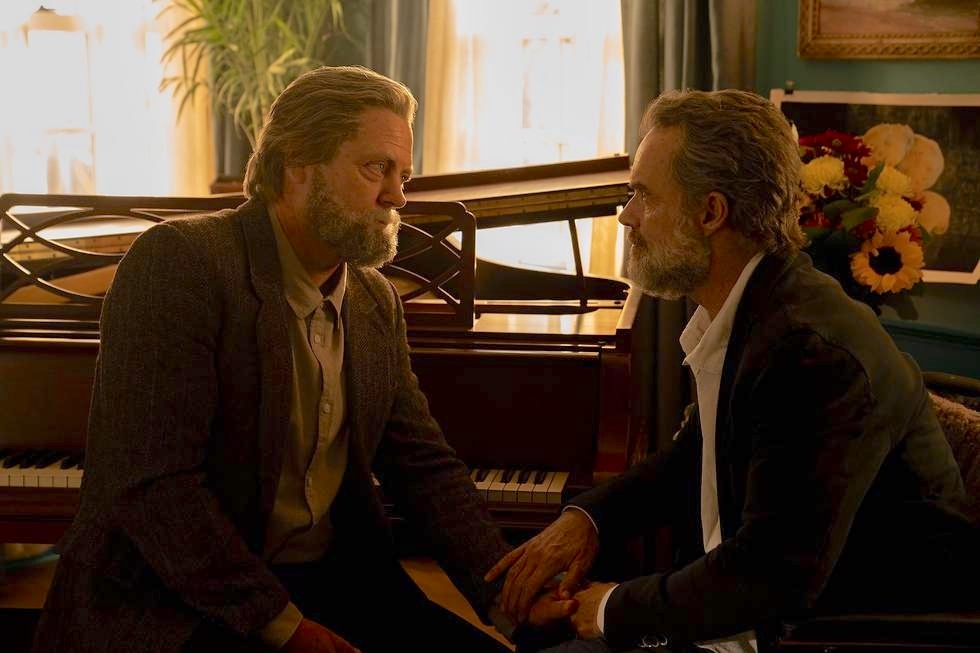Anyone logging on to Twitter Monday morning, would have been immediately bombarded with expressions of reverence, joy, tears and delight at the previous night’s episode of The Last of Us.
The Last of Us is HBO’s prestige TV/streaming adaptation of the popular video game of the same name about a fungus-driven zombie apocalypse. It stars Bella Ramsey as Ellie, a girl holding the possible cure, and Pedro Pascal as Joel, the grizzled father figure bent on protecting her. Three episodes in and the series has experienced near universal critical acclaim for its lavish production, stellar acting and faithful adaptation of the beloved franchise.
But its third episode, which dropped Sunday, has been the buzziest yet, largely for its departure from the source material. The story expands on the side character of an old friend of Joel’s, Bill (Nick Offerman), seen briefly in the game, and fleshes out his backstory and romance with another man, played by HBO’s in-house gay king Murray Bartlett. The two share wine and strawberries, have sex, grow old together and eventually meet a Shakespearean end. It’s a Pixar-level emotional pastoral daddy bear fantasy overlaid with all the trappings of prestige TV including the requisite sentimental music drops and tear-jerking moments (seriously, there’s a softly lit in-home marriage ceremony accompanied by a Max Richter composition—it’s not subtle).
The episode was immediately lauded with lavish critical praise, think pieces on “what it means for queer gamers” and a lot of crying emojis and declarations of it being “groundbreaking” and “the greatest gay love story of all time” on social media. The show’s hashtag trended on Twitter throughout the day Monday as fans shared their reactions.
The swell of love was also inevitably followed by contrarian takes arguing against putting the episode on a pedestal, including from Jackson McHenry in Vulture, who wrote about the show’s general “emptiness” and the episode’s emotional manipulation.
“The show makes a lot of metaphorical hay of the notion that Frank is going to get Bill to open up by way of getting him to grow strawberries; as soon as the episode depicted them bickering over Frank trading for seeds, I let out a groan anticipating the moment where said strawberries would be dramatically shared as a symbol of emotional and actual growth,” McHenry wrote.
The social media reaction prompted me to catch up on all three episodes Monday night, and my overall opinion was: it’s fine! I was tickled by some of the more intimate moments. I like Murray Bartlett and Nick Offerman. I was charmed! But the episode also felt overly saccharine, and to be honest, didn’t fully live up to what I expected based on the reactions online. Offerman and Bartlett gave two emotions—gruff and hopeful, respectively. A manipulative tear-jerker is not novel. Nor is the idea that two men could fall in love at the end of the world.
I don’t want to take away from the people who were immensely touched by the episode. But the outsize reaction both for and against the episode says something more broadly about where we are when it comes to queer storytelling in 2023, and how folks—queer and straight alike— still haven’t figured out how to talk about queer storylines.
What makes a queer storyline in a TV show or movie “important?” Certain pieces of media move us more than others, whether by intention or not—think of the tender, young love of Heartstopper. Certain storylines are milestones for showing realistic stories on screen or mark progress in an industry that historically has been shitty to marginalized folks—think of the pioneering work Leo Sheng does for transmasc representation on The L Word: Generation Q. Certain things just straight up have never been done before and it’s important to note that—like basically all of Pose (and capped by M.J. Rodriguez’s historic Golden Globes win).
In the past few decades, we’ve thankfully moved on from the “having a queer person involved is enough” approach to critical praise. Now, tons of stuff of varying degrees of quality has queer folks in it. I couldn’t even catch every queer film at Sundance this year because there were, frankly, too many. And I do think we’ve also moved on from the “okay, well now we need a queer person who doesn’t suffer” critique. The “bury your gays” trope is occasionally still a thing, but showrunners and writers have largely wised up to the bad optics of killing off queer characters.
That’s all to say, my trepidation with the ravenous acclaim for this episode of The Last Of Us is rooted in the fact that we have literally seen this before—it’s the same plot as the critically acclaimed “San Junipero” episode of Black Mirror from seven years ago, but with old bears instead of old lesbians, Linda Ronstadt instead of Belinda Carlisle, and the same tragically romantic decision at the end. If you want sentimental or epic gay love stories more broadly, you can probably find one in just the past year with Heartstopper, Spoiler Alert, Fire Island and a slew of others. And Murry Bartlett himself has played a gay character on HBO almost half a dozen times over the course of his career.
So what makes The Last of Us different from those queer stories before it? The answer is blunt: nothing. It’s another relatively well-executed piece of prestige queer media to slot into the rainbow mosaic we’ve been building on screen for decades. It’s a tear-jerker by design, featuring beloved actors in a franchise with a built-in fan base. I’m glad it exists, just as I’m glad “San Junipero” and Sense8 and Sex Education and Glee and everything else that paved the way before and after them exists. I’ve watched a lot of queer TV and film in my life, and I plan on watching a lot more.
But I do think, broadly, that this episode and its reaction is a good push for critics and audiences to step back and reassess the playing field when it comes to queer representation on screen, and to stop rushing to treat every moment that comes as “groundbreaking” as our default critical lens. Again, this episode is pleasant, if emotionally overwrought. It’s not really doing anything particularly new. But when we do frame everything around whether it’s an “important” gay story or not, we end up with Billy Eichner and Todrick Hall wondering why their specific poorly made queer thing didn’t get the “it’s important!” treatment.
We can talk about queer storylines without infantilizing them simply as heartwarming or groundbreaking for doing the minimum of showing gays on screen who don’t die tragically (okay, that last bit actually does apply to The Last of Us). We can allow them to breathe and to exist and to skate by as another episode, rather than the “very special episode” the The Last of Us showrunners and actors framed this as in a pile of interviews before and after it aired. It’s okay for queer art to be—to borrow a Gen Z term—“mid,” as in “middling”; fine and simply good rather than great.
We live in a moment of, for the most part, bountiful representation in TV and film, where an Oscars race can feature expressions of queerness ranging from the subtle family dynamics of Everything Everywhere All at Once to a serial abuser in Tár. Every queer story on screen doesn’t have to change the world or be a bastion of representation for queer folks, and we don’t have to praise it like it does or chastise it when it fails to do either. Thankfully, we’ve moved past the era of “gay thing on screen = good.”
It’s 2023! Let queer art be mid!


 Why you can trust Xtra
Why you can trust Xtra


